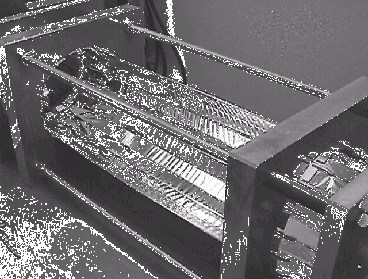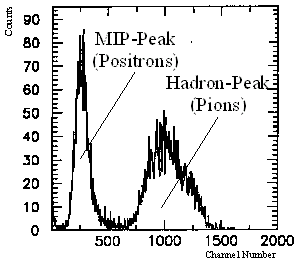






An important constraint was a negligible energy loss and a low photon conversion probability. This was achieved by a self supporting structure made of Mylar and Rohacell which results in low specific masses of 36 mg/cm2 for the inner and 43 mg/cm2 for the outer chamber.
Two cylindrical MWPCs are surrounding the target located between target and calorimeter. They are located 60.15 mm and 120.1 mm radially from the target centre. The anodes that consist of 192 wires for the inner and 385 for the outer chamber are sandwiched between the cathodes. The anode wires are made from 20 µm diameter gold-plated Tungsten. For both chambers the wire spacing is 1.96 mm. The cathodes of the inner chamber are divided into strips of 3 mm that are wound as a helix with 35°, while the slope of the 2.4 mm wide strips of the outer chamber are at about 44°. The cathode material is aluminium; mylar is used for the electrical insulation. The gas mixture consists of 49.9% argon, 49.9% ethane and 0.2% freon (CBrF3).
The wire chambers were designed and manufactured at JINR, Dubna (Russia). They have been tested using a 90Sr electron source. An efficiency of 99.9% was measured by inserting a plastic scintillator behind the two wire chambers for normalization. An azimuthal position resolution of 0.2 mm was obtained as well [Kho98].

For an efficient discrimination of heavy charged particles, minimum ionizing and neutral particles, the MWPCs must be complemented with a plastic scintillator. Its thickness of 3.2 mm is sufficient to identify minimum ionizing particles but still adequate to keep the conversion probability for both photons and positrons low. In this way they can veto charged tracks for the p b trigger and veto neutral tracks for the p +->e+ n e trigger.
The plastic scintillator hodoscope consists of 20 strips with an active length of 600 mm and a thickness of 3.2 mm. They form a regular icosagon that directly encases the outer MWPC. Each of the modules is coupled via light guide at both ends to photomultiplier tubes. The strips are wrapped in aluminized mylar to provide efficient light transport before the readout. The hodoscope has been successfully tested during the calibration beam periods in 1996 and 1997 as can be seen in Figure 2-3.






